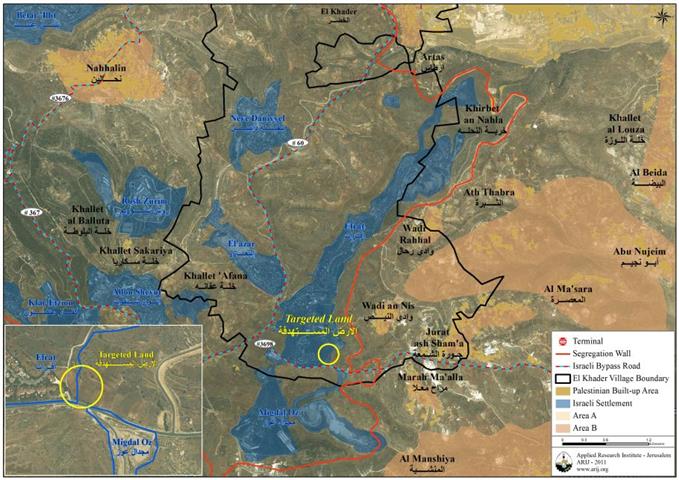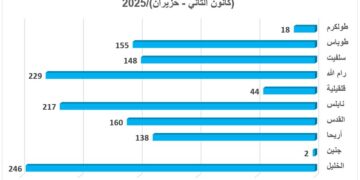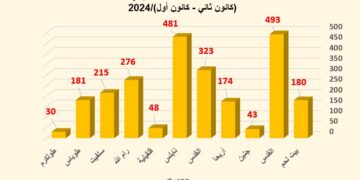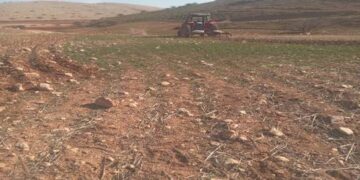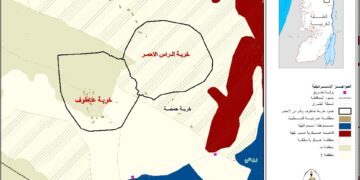On March 30, 2011, Israeli settlers from the Illegal Israeli settlement of Efrat located southwest of Bethlehem city, and is one of the settlements comprising the Gush Etzion settlement bloc, stormed under the protection of the Israeli occupation army ‘Hreiqet Qiqan’ area in Al Khader village, located inside the boundary of Efrat settlement and uprooted dozens of Olive and other fruit trees planted in 13 dunums of owned-Palestinian lands. The targeted lands are owned by 4 Palestinian farmers from Al- Khader village, they are: Mr. Khalid Ibrahim Subeih, Mr. Taleb Khalil Subeih, Mr. Fawwaz Jamil Subeih and the sons of Naji Shihadeh Ghuneim, and located few meters away from Efrat settlement.
In an interview conducted by ARIJ field team, Mr. Taleb Khalil Subeih indicated that their lands are adjacent to Efrat settlement and they used to cultivate it for tens of years, where they usually enter to their lands after taking the permission of the Israeli guards manning the entrance of the settlement since their lands are located inside the settlement’s borders. Mr. Khalil added that he, along with other land owners, who were targeted by the latest Israeli attack, had never got any Israeli warning or military order from the Israeli Occupation Authorities. He also added that the guards of the settlement humiliate them every time they try to access their lands, impose obstacles, and prevent them from bringing the needed equipments for cultivating their lands under flimsy pretexts. See the map below:
Map 1: the targeted lands in Al Khader Village
Al- Khader village is located some 4.5 kilometers west of Bethlehem city. It is bordered by Bethlehem city from the east, Husan and Battir villages from the west and northwest, Al Doha and Beit Jala cities from the north and northeast, and Al Duheisha Refugee camp and Artas villages from the south. The built-up area of Al- Khader village spreads on 601 dunums of land, about 3% of the village’s total land area (20,090 dunums). The village is home to 11,666 inhabitants (PCBS 2010), most of whom tended to work in agriculture, where the rich and fertile soil has made farming and agriculture feasible in the village, therefore, agriculture has been and is still considered the major source of income for residents of the village.
The Geopolitical Divisions of Al-Khader Village Lands
According to the Oslo II Interim Agreement that was signed in September 1995 between the Palestinian Liberation Organization (PLO) and Israel, the Palestinian areas in the West Bank were classified into three areas:
-
Area A: the Palestinians have complete autonomy over administrative and security issues.
-
Area B: The Palestinians have full control over the civil responsibilities and Israel continues to have overriding responsibility for security;
-
while Area C: Israel retains full control over security and administration related to territory.
Accordingly, the 20,090 dunums of Al- Khader Village were classified to areas A, B and C, 565 Dunums, of which were classified as area ‘A’ ( 2.8 % of the total village area) where most of the built up area is concentrated; while 1,176 dunums (5.9% of the total village area) were classified as areas ‘B’; while the remaining area of the village, a total of 18,349 dunums of Al-Khader village lands were classified as areas ‘C’ (91.3 % of the total village area) and include all the agricultural lands and open spaces. See table 1 below:
|
Table 1: Geopolitical Division of Al Khader Village according to Oslo II Interim Agreement of 1995
|
|
Classification of Lands
|
Area in dunums
|
% of the Village’s total area
|
|
Area A
|
565
|
2.8
|
|
Area B
|
1,176
|
5.9
|
|
Area C
|
18,349
|
91.3
|
|
Total Area
|
20,090
|
100
|
|
Source: ARIJ GIS Unit – 2011
|
The Israeli Colonial Activities in Al-Khader Village
The Israeli colonial activities in Al Khader village started right after the Israeli Occupation of the West Bank and the Gaza strip in 1967. Throughout the years of occupation, the village of Al Khader lost 2791 Dunums (13.8% from the total village lands) for the establishment of 6 Israeli settlements, Neve Daniel, Alon Shevut, Rosh Tzurim, Efrat and Ele’azar and Migdal ‘Oz; not forgetting to mention the lands that were confiscated and used for the construction of Israeli Bypass Roads to link Israeli settlements with each other. Table 2 below lists the Israeli settlements that were established on the lands of Al Khader Village:
|
Table 2: Israeli Settlements established on land of Al Khader Village
|
|
Israeli Settlement
|
Date of Establishment
|
Population
|
Area
(Dunums)
|
Location
|
|
Rosh Zurim
|
1969
|
302
|
3
|
West of Al Khader (Bethlehem)
|
|
Allon Shevut
|
1971
|
2,960
|
38
|
Southwest of Al Khader (Bethlehem)
|
|
Migdal Oz
|
1977
|
327
|
45
|
South of Al Khader (Bethlehem)
|
|
Neve Daniel
|
1982
|
1,065
|
583
|
Southwest of Al Khader (Bethlehem)
|
|
El’azar
|
1975
|
870
|
449
|
Southwest of Al Khader (Bethlehem)
|
|
Efrat
|
1979
|
6,996
|
1,673
|
Southeast of Al Khader (Bethlehem)
|
|
Total
|
***
|
12,520
|
2,791
|
***
|
Furthermore, The Israeli Segregation Wall constitutes another Israeli colonial tool to loot as much land as possible from Al-Khader village, where it stretches 6.7 km on the lands of the village and cuts most of the village’s agriculture lands and open spaces. When completed, the Segregation Wall will lead to the isolation of 15,144 dunums of the village lands (75.4% of the total village’s lands).
To Conclude
The International community (the Quartet, the European Union, and the United States) the main sponsors of the “peace process”, must put an end to the Israeli expansionist plans and Illegal violations which are being conducted on daily-basis and targeting the Palestinian people and their properties. These violations constitute a grave breach of the International law rules and conventions such as:-
-
Uprooting of trees owned by residents of the OPT violate the trade policies of the Paris protocols of 1954 which calls for ‘free access for Palestinian goods to the Israeli market and vice versa.’ The curfews and the uprooting are a clear violation of this clear security.
-
Article 147 of the Fourth Geneva Convention indicated that: Extensive destruction and appropriation of property not justified by military necessity and carried out unlawfully and wantonly. Is a grave breach of the Convention.
-
In addition, the uprooting and the closures are a clear violation of Article 23 of The Hague Convention Art. 23 of the Hague Convention of 1907 also provides: In addition to the prohibitions provided by special Conventions, it is especially forbidden to destroy or seize the enemy’s property, unless such destruction or seizure be imperatively demanded by the necessities of war.
-
Also Under the Universal Declaration of Human Rights adopted and proclaimed by General Assembly resolution 217 A (III) of, December 10, 1948, Article 17 reads: ‘No one shall be arbitrarily deprived of his property.’ Which means it bans Israel from destroying or confiscating the property of the Palestinians at any case.

